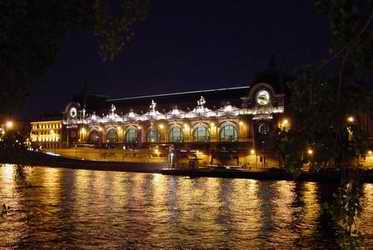Paris Orsay Museum formerly train station and luxury hotel, the Orsay Museum is today one of the most visited museums in France.
Almost opposite the Louvre Museum , across the Seine, a large structure of 188 meters long by 75 meters wide and 32 meters high is imposed by the dock: The Orsay Museum . One of the museums ‘new’ in France and yet it is the third most visited, with over 2.5 million visitors per year. A special feature is that it was housed in the former railway station of the city.

Back in 1600, the area was a large garden belonging to Queen Margaret of Valois , wife of Henry IV divorced. When she died, the space was sold in batches and aristocratic mansions built, giving the area an air of elegance and prestige.
So, coming to the nineteenth century, the site of the current museum was occupied by the Cavalry Barracks and the Palais d’Orsay . Commune At times, the whole neighborhood was burned and charred walls of the Palais d’Orsay remained so until in 1900, on the eve of the World Expo , the state gave the land to the railroad company of Orleans.
It is planned to build on the site a new station in a more central the Austerlitz station, then the most important. Those selected to address the project were Lucien Magne , Emile Bénard and Victor Laloux (the latter responsible for the restoration of City of Paris). The challenge was great: it was to integrate a cold iron structure in an elegant neighborhood and near the Louvre and other palaces. Construction took two years and 14 July 1900 were inaugurated the station and luxurious Orsay. ran the station until 1939, then it was that girl and was impractical.
The abandoned building was the setting for several films, among including Process , Orson Wells, and was a refuge for the Renaud-Barrault theater company. In 1973 also stopped working Orsay hotel. Directorate of Museums of France looking for a place to stay then collections of art from the second half of the nineteenth century, and the old station building, about to be demolished and replaced by a modern, attracted attention and was declared a historic monument in 1978, while President Valéry Giscard d’Estaing authorized the creation of the new museum.
His successor, François Mitterrand , who was on 1 December 1986 opened the Musée d’Orsay. Adaptation of the season was a huge challenge, both technically and aesthetically. Organized in three levels and respecting the original architecture Laloux, Orsay Museum consists of about 80 rooms or galleries with over 4000 exhibits permanently, temporary exhibition halls, hall, auditorium, cafes and restaurants. collections gathered in Orsay Museum covering the period 1848-1914 and were taken from the Louvre (works by artists born after 1820), the Jeu de Paume Museum (devoted to impressionism since 1947) and the Museum of Modern Art , which had been installed at the Centre Pompidou retained only the works of authors born after 1870. The museum’s collections include not only paintings and drawings (counted about 15,000!)
But extend to other disciplines such as photography that emerged in this period, and also brings architecture 14,000 projects, 2,400 sculptures, 1,300 objects and furniture Art … Constantly heritage is enriched with acquisitions and donations.
Among the most prominent authors and works that can be admired in the Musée d’Orsay can quote Ingres ( La Source ), Degas ( Dancer dressed ), Millet ( Angelus , La Primavera ), Camille Corot ( A matinee. Dance of the Nymphs. ), Courbet ( The Origin of the World , The Artist’s Studio ), Monet ( The picnic ), Renoir ( The Moulin de la Galette ), Cezanne ( The woman in the coffee , Portrait of the Artist’s Mother ), Gauguin ( Self-Portrait with Yellow Christ ), Van Gogh ( The arlesiana , The Church of Auvers ) and Manet ( Olympia ).